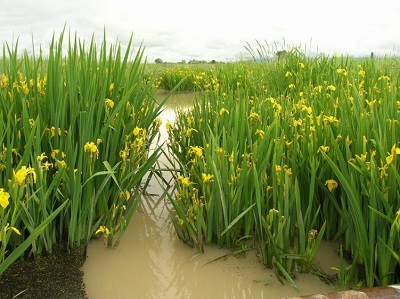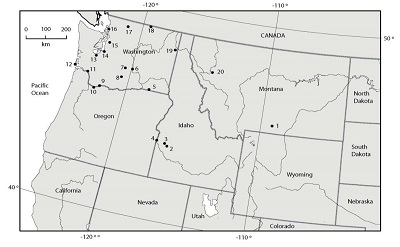Yellowflag iris reproduction- March 2015
Download this weed post on yellowflag iris reproduction as a PDF
By Dr. John Gaskin, USDA-ARS, Sidney, MT. [email protected]
Yellowflag iris is an invasive plant that is typically found emerging from shallow portions of rivers, lakes and canals, but can also grow in highly saturated soils. It exists throughout most of the USA and Canada but is native to Europe, Asia and Africa. It first arrived in the northwestern USA in 1948. It has been widely used as an ornamental and all parts of the plant are poisonous to livestock and may cause skin irritation in humans.

Yellowflag iris infestation. Note brown seeds floating on surface of water.
Yellowflag iris can produce hundreds of seeds per plant each year and can also spread vegetatively via rhizomes and rhizome fragmentation, but we are not sure which method is most common in the North American invasion. Many aquatics reproduce vegetatively to increase patch size or disperse long distances. Plant fragments can break off and be transported downriver or across a lake. This can be a successful strategy as relatively large pieces of plant are a big source of energy for starting a new individual, in contrast to seeds which are typically pretty small and carry fewer resources. Aquatic invaders that often rely heavily on vegetative reproduction include milfoil, water hyacinth, flowering rush, alligatorweed, primrose willow, and Brazilian waterweed. In the native range, spread of yellowflag via rhizomes was reported to be more common than by seed, and patches 20m across were thought to be shoots all connected underground. In Montana, one older report (without data) suggested seed is the main method of local spread and distribution, but in western Washington it is reported that up to several hundred shoots can be connected underground via rhizomes.
To figure out how yellowflag is expanding in the West, we turned to DNA. We can look at DNA fingerprints of plants and determine if genotypes are identical, suggesting spread by vegetative parts, or different, suggesting sexual reproduction by seed (this species does not self-pollinate).

Yellowflag iris sampling locations (indicated by dots).
We collected 174 plants from 20 populations in MT, ID, OR and WA. Plants were 5m apart in a linear transect in one large population (Ninepipes, MT), or 2m apart on a 40m transect. The DNA fingerprints (AFLPs, or Amplified Fragment Length Polymorphisms) found only two plants with identical genotypes, and these two were next to each other in the same population. Now we know that this plant hardly ever reproduces by vegetative fragments. Two plants a foot apart may be clones, but at 6 feet apart or more, they are almost exclusively not clones. We also collected seed from 20 populations from the Ninepipes, MT, area and found seed viability averaged 99%. So, why is it important to know that this species spreads mostly by seed, both locally and long distance? It tells us that if you manage yellowflag iris before its seeds mature, you might be preventing the next downstream invasion. It also tells us that this species has high genetic diversity, which can help plants adapt to new environments and strong selection pressures (such as heavy herbicide use).
For more information, see the MSU Extension bulletin "Biology, Ecology, and Management of Yellowflag Iris"
